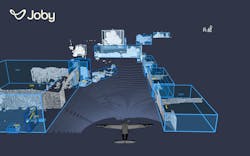Joby Aviation collaborates with NVIDIA to advance autonomous flight with IGX Thor platform
Summary Points:
- IGX Thor, based on NVIDIA's Blackwell architecture, supports advanced physical AI applications
- Partnership to accelerate Joby’s Superpilot autonomous flight technology for defense and civil systems
- Features include autonomous mission management, sensor fusion, and predictive system health monitoring
SANTA CRUZ, Calif. - Joby Aviation Inc. in Santa Cruz, Calif., announced a collaboration with NVIDIA in Santa Clara, Calif., naming Joby as the only aviation launch partner for the new NVIDIA IGX Thor platform. Powered by NVIDIA's Blackwell architecture, the industrial-grade platform is designed to support the next generation of physical AI applications. The collaboration aims to advance Joby's Superpilot autonomous flight technology across military and civil platforms.
"The autonomous systems under development at Joby are poised to complement human intelligence by providing speed, precision, and stamina beyond what a person alone is capable of," said Gregor Veble Mikic, flight research lead at Joby. "To achieve this, an aircraft needs a powerful onboard computer that can interpret extraordinary amounts of information to make decisions in real time. Combining NVIDIA's compute power with our world-class aircraft design, certification, and rigorous flight testing capabilities, we're enabling a new era of safety-first autonomy in aviation."
Joby is developing Superpilot to interact with the world through a continuum of autonomous functions. NVIDIA's support for industry-recognized functional safety standards on the IGX Thor platform enables Joby to pursue certifiable autonomy for near-term defense and long-term civil applications as the Federal Aviation Administration advances autonomous flight integration into national airspace.
Related: Joby delivers commercial eVTOL to UAE
Integrating this level of onboard compute can enhance operational safety and mission capability through real-time capabilities such as:
Autonomous mission management: Enables the aircraft to determine, request, and follow optimal flight paths, adapting to changes in weather, air traffic control instructions, or unexpected events, with intuitive human-machine teaming to ensure mission success.
Radar and perception processing: Onboard compute processes high-rate data from radar, LiDAR, and vision sensors to provide environmental awareness, object perception, and localization for safe navigation in all conditions.
Related: Beta’s Alia CX300 pushes electric aviation toward practical use
Sensor fusion: High-performance processing combines data from multiple sensors to deliver accurate aircraft state estimation and situational awareness in complex environments.
The system also provides a foundation for features that improve operational insight, reliability, and performance:
Predictive system health monitoring: The aircraft refines models of its own function and reliability, predicting when components may need attention and alerting crews before a failure occurs.
Digital twin modeling: With reliable compute capabilities, an aircraft can host a digital twin of itself and its environment, collecting flight data to improve fidelity and integrating this information into mission control systems to optimize performance and efficiency.
"Autonomous cars have showcased the ability to interpret large volumes of data to make split-second decisions," Mikic said. "For an aircraft, the compute power needed for autonomy is similarly high but must meet even higher levels of design rigor to achieve certification for operation in controlled airspace. In aviation, every calculation must be perfect, and every decision infallible."
About the Author

Jamie Whitney
Jamie Whitney joined the staff of Military & Aerospace Electronics and Intelligent Aerospace. He brings seven years of print newspaper experience to the aerospace and defense electronics industry.
Whitney oversees editorial content for the Intelligent Aerospace Website, as well as produce news and features for Military & Aerospace Electronics, attend industry events, produce Webcasts, oversee print production of Military & Aerospace Electronics, and expand the Intelligent Aerospace and Military & Aerospace Electronics franchises with new and innovative content.
